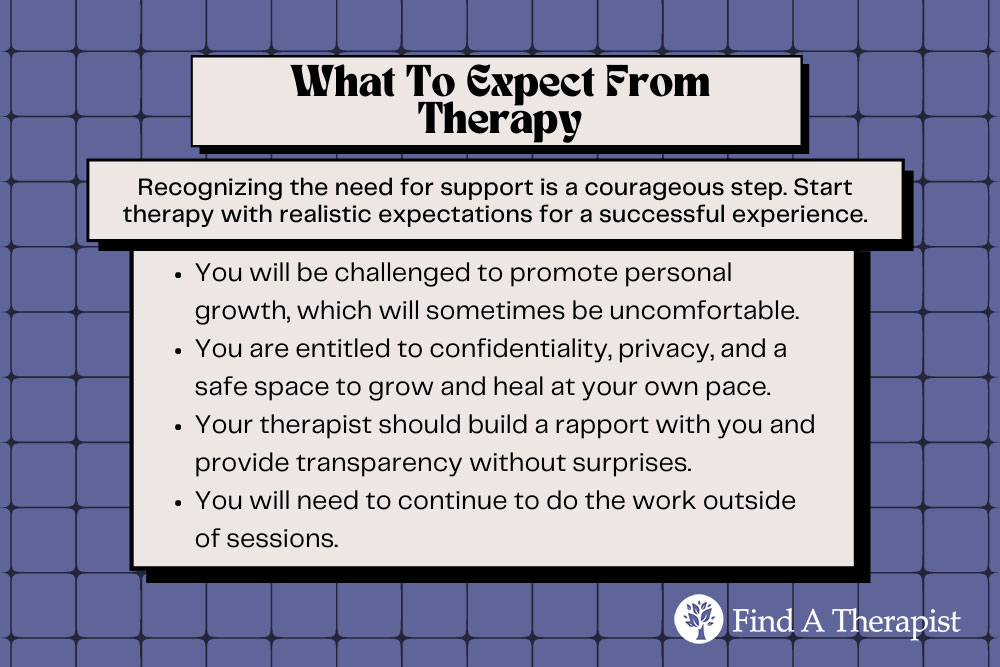Understanding How Therapy Works
Published on August 6th, 2021
Updated on February 3rd, 2024

People seek therapy for a range of different reasons. Therapy is most often sought for mental health disorders, addiction, grief, relationships, or life transitions. The stigma around mental health often stops many from getting the help they need. This is often due to not understanding how therapy works or what to expect from therapy.
Benefits of Therapy
Therapy can help people gain insight into their thoughts, feelings, and behaviors. Those in therapy often achieve less anxiety, resolved issues, and stronger relationships. The following are ways that therapy can help:
- Relieve psychological and emotional symptoms
- Improve relationships
- Reduce symptoms and improve overall health
- Change unhealthy habits
- Explore hidden desires
- Crisis management
Not all therapy looks the same. Therapy is diverse and has a variety of different approaches. Each approach has its own perspective. This serves as a “roadmap” to guide therapists when helping their clients.
Sponsored by

Choose a therapist to work with and start healing with 20% off from BetterHelp.
Click HereTherapists, counselors, and psychologists can draw from one or more approaches in their work with clients. Some common therapy approaches include:
- Cognitive-behavioral therapy (CBT) is a short-term, goal-oriented approach to therapy. It focuses on changing patterns of thinking and behavior that contribute to a person’s struggles.
- Psychodynamic therapy focuses more on people’s emotional and mental processes than their behavior. Psychodynamic therapy can help people gain insight into their current identity.
- Existential therapy takes a philosophical perspective. It focuses on the concepts relevant to all humans, including death and the meaning of life.
- Mindfulness-based cognitive therapy (MBCT) combines approaches from CBT and mindfulness strategies. This is used to help people identify and modify automatic thoughts that contribute to their problems.
A therapist’s chosen approach(es) will affect what occurs in their work with their clients.
Regardless of the approach used, psychotherapy is, first and foremost, a collaborative treatment. It is based on the relationship between a client and their therapist. The rapport that a therapist has with their client significantly affects the therapeutic process.
A client’s therapeutic process will be impacted if they are not comfortable with their therapist. Treatment is less successful in these cases than in cases where there is a good rapport between therapist and client.
Qualities of a good therapeutic relationship include:
- Mutual trust
- Respect
- General agreement on goal(s) of therapy
- Mutual engagement during the therapy sessions
- Shared decision-making
- The freedom to share negative emotional responses
- The ability to speak about any problems or issues that could arise in the relationship

How to Know if Therapy is Working
Measuring success in therapy may look different from one person to another. This is partially because success can mean different things to different people. Additionally, progress in therapy happens over time. While some people may experience those big A-HA! moments, most find therapy is a series of small breakthroughs and gradual growth.
People may know therapy is working for them if they start to feel better. they may find that their symptoms are decreasing or more well-managed. Additionally, therapy shouldn’t feel like just talking to a friend. It should actually feel a bit uncomfortable sometimes. A therapist’s role is to push their clients to talk about difficult things, which is often where the root cause(s) of issues are.
Another sign of effective therapy is that there are clearly defined goals. Goals are typically set in the first couple of sessions and revisited throughout treatment.
Goals in therapy help shape the plan for the therapeutic process. A treatment plan will include:
- Goals that the client wants to achieve
- The therapist’s recommendations about how to achieve those goals
- A plan for how to apply therapeutic tools to achieve the client’s goals
- Updates on the client’s progress toward achieving their goals
Example: A goal in therapy might be to improve self-care. This can be done through practicing meditation and journaling. In this example, the goal is clearly defined and there are actional steps that will be taken to achieve the goal.

Misconceptions About Therapy
There are common misconceptions about therapy that prevent people from seeking help. Confronting those misconceptions is an essential part of spreading awareness about mental health. The following are common misconceptions about therapy:
Seeking therapy makes you weak. Seeking therapy is actually a sign of the exact opposite; it is a sign of strength.
Therapy is expensive. Most individual therapy ranges in price, anywhere from $75 to $150 per hour. But for those who can’t pay that, there are some affordable options.
Depending on where an individual lives, they may be able to find affordable options. This includes therapy groups or free therapy from master-level students. Additionally, many health insurance plans now cover mental health.
Therapy changes you into a different person. A good therapist helps a client be the kind of person that they want to be, not the person the therapist wants them to be.
Therapy is for people with serious issues. Many believe therapy is only for those who have been diagnosed with a mental or psychological disorder. While therapy is important for those people, all kinds of people seek therapy, from those dealing with day-to-day stress to those wanting to live life to the fullest.
What To Expect Of Yourself While In Therapy
A healing process does not always feel good, and therapy is no different. Therapy can be challenging, but also rewarding. As long as you commit to your healing process while in therapy, you can recover from the mental health challenges you are struggling with. The following are things to keep in mind when considering what to expect of yourself while in therapy:
Therapy requires commitment and patience. Therapy should be considered a priority, not a hobby or errand. Missing appointments and not applying what you learn in therapy to your life will make it difficult to see progress.
Note: Progress in therapy is not linear. You will have points of ease and challenge at any point in your recovery process.
Be patient with yourself. Therapy can be hard, and takes time. Progress in therapy tends to be gradual and starts when you begin to build rapport with your therapist. Once you establish a routine in therapy, you may feel more confident in the process, but this takes time.
Take a break if you need it. Sometimes, a person in therapy starts to feel overwhelmed with the process. If you need a break, talk about it with your therapist. Discuss with your therapist your reasoning and the length of time that you will break so it is beneficial rather than detrimental to your healing.
Review your progress with your therapist. If you’re feeling as if your progress has stalled, ask your therapist to review your progress with you. Share your thoughts and ongoing needs. You may also consider revising your treatment goals to be more in line with how you want to change and grow.
Self-Care While You Are In Therapy
Self-care can be challenging, but it is also part of investing in your wellness. Physical, psychological, emotional, and spiritual imbalances are all connected. If one area is unbalanced, other areas may also be unbalanced.
When you are in therapy, you are working to heal. Healing requires support and that is essentially what self-care provides- a means for you to support yourself. When practiced regularly, self-care can promote healing.
Sponsored by

Find an affordable therapist online with 20% off from BetterHelp.
Click Here






Leave A Reply